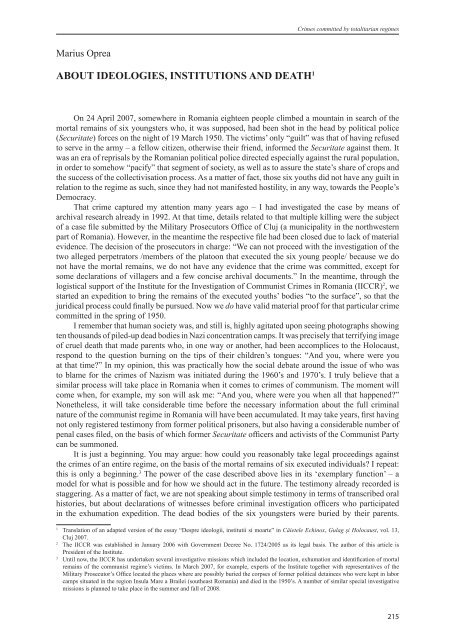crimes committed by totalitarian regimes - Ministrstvo za pravosodje
crimes committed by totalitarian regimes - Ministrstvo za pravosodje
crimes committed by totalitarian regimes - Ministrstvo za pravosodje
Create successful ePaper yourself
Turn your PDF publications into a flip-book with our unique Google optimized e-Paper software.
Crimes <strong>committed</strong> <strong>by</strong> <strong>totalitarian</strong> <strong>regimes</strong><br />
Marius Oprea<br />
About ideologies, institutions and death 1<br />
On 24 April 2007, somewhere in Romania eighteen people climbed a mountain in search of the<br />
mortal remains of six youngsters who, it was supposed, had been shot in the head <strong>by</strong> political police<br />
(Securitate) forces on the night of 19 March 1950. The victims’ only “guilt” was that of having refused<br />
to serve in the army – a fellow citizen, otherwise their friend, informed the Securitate against them. It<br />
was an era of reprisals <strong>by</strong> the Romanian political police directed especially against the rural population,<br />
in order to somehow “pacify” that segment of society, as well as to assure the state’s share of crops and<br />
the success of the collectivisation process. As a matter of fact, those six youths did not have any guilt in<br />
relation to the regime as such, since they had not manifested hostility, in any way, towards the People’s<br />
Democracy.<br />
That crime captured my attention many years ago – I had investigated the case <strong>by</strong> means of<br />
archival research already in 1992. At that time, details related to that multiple killing were the subject<br />
of a case file submitted <strong>by</strong> the Military Prosecutors Office of Cluj (a municipality in the northwestern<br />
part of Romania). However, in the meantime the respective file had been closed due to lack of material<br />
evidence. The decision of the prosecutors in charge: “We can not proceed with the investigation of the<br />
two alleged perpetrators /members of the platoon that executed the six young people/ because we do<br />
not have the mortal remains, we do not have any evidence that the crime was <strong>committed</strong>, except for<br />
some declarations of villagers and a few concise archival documents.” In the meantime, through the<br />
logistical support of the Institute for the Investigation of Communist Crimes in Romania (IICCR) 2 , we<br />
started an expedition to bring the remains of the executed youths’ bodies “to the surface”, so that the<br />
juridical process could finally be pursued. Now we do have valid material proof for that particular crime<br />
<strong>committed</strong> in the spring of 1950.<br />
I remember that human society was, and still is, highly agitated upon seeing photographs showing<br />
ten thousands of piled-up dead bodies in Nazi concentration camps. It was precisely that terrifying image<br />
of cruel death that made parents who, in one way or another, had been accomplices to the Holocaust,<br />
respond to the question burning on the tips of their children’s tongues: “And you, where were you<br />
at that time?” In my opinion, this was practically how the social debate around the issue of who was<br />
to blame for the <strong>crimes</strong> of Nazism was initiated during the 1960’s and 1970’s. I truly believe that a<br />
similar process will take place in Romania when it comes to <strong>crimes</strong> of communism. The moment will<br />
come when, for example, my son will ask me: “And you, where were you when all that happened?”<br />
Nonetheless, it will take considerable time before the necessary information about the full criminal<br />
nature of the communist regime in Romania will have been accumulated. It may take years, first having<br />
not only registered testimony from former political prisoners, but also having a considerable number of<br />
penal cases filed, on the basis of which former Securitate officers and activists of the Communist Party<br />
can be summoned.<br />
It is just a beginning. You may argue: how could you reasonably take legal proceedings against<br />
the <strong>crimes</strong> of an entire regime, on the basis of the mortal remains of six executed individuals? I repeat:<br />
this is only a beginning. 3 The power of the case described above lies in its ‘exemplary function’ – a<br />
model for what is possible and for how we should act in the future. The testimony already recorded is<br />
staggering. As a matter of fact, we are not speaking about simple testimony in terms of transcribed oral<br />
histories, but about declarations of witnesses before criminal investigation officers who participated<br />
in the exhumation expedition. The dead bodies of the six youngsters were buried <strong>by</strong> their parents.<br />
1<br />
Translation of an adapted version of the essay “Despre ideologii, institutii si moarte” in Cǎietele Echinox, Gulag şi Holocaust, vol. 13,<br />
Cluj 2007.<br />
2<br />
The IICCR was established in January 2006 with Government Decree No. 1724/2005 as its legal basis. The author of this article is<br />
President of the Institute.<br />
3<br />
Until now, the IICCR has undertaken several investigative missions which included the location, exhumation and identification of mortal<br />
remains of the communist regime’s victims. In March 2007, for example, experts of the Institute together with representatives of the<br />
Military Prosecutor’s Office located the places where are possibly buried the corpses of former political detainees who were kept in labor<br />
camps situated in the region Insula Mare a Brailei (southeast Romania) and died in the 1950’s. A number of similar special investigative<br />
missions is planned to take place in the summer and fall of 2008.<br />
215




